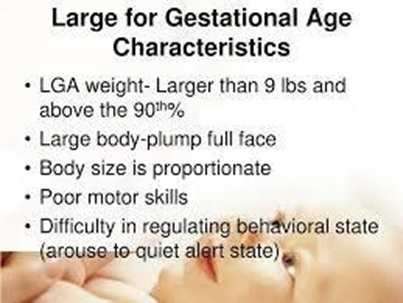The nurse prepares to assess a newborn who is considered to be large-for-gestational-age (LGA). Which characteristic would the nurse correlate with this gestational age variation?
birthweight of 7 lb, 14 oz (3,572 g)
strong, brisk motor skills
difficulty in arousing to a quiet alert state
wasted appearance of extremities
The Correct Answer is C
A. A birthweight above the 90th percentile for gestational age is characteristic of large-for-gestational-age newborns. The above birth weight is within the normal ranges.
B. Strong, brisk motor skills are not necessarily indicative of being large-for- gestational-age.
C. Large-for-gestational-age newborns. They may have difficulty in arousing to a quiet alert state due to hypoglycemia, hypocalcemia, or polycythemia.
D. A wasted appearance of extremities is more indicative of intrauterine growth restriction (IUGR) rather than being large-for-gestational-age. LGA newborns typically have plump and rosy appearance.

Nursing Test Bank
Naxlex Comprehensive Predictor Exams
Related Questions
Correct Answer is D
Explanation
A. Asphyxia would typically manifest differently on a chest X-ray, possibly showing signs of lung collapse or consolidation.
B. Persistent pulmonary hypertension may present with other radiographic findings, such as enlargement of the heart or signs of pulmonary edema.
C. Transient tachypnea of the newborn might not produce a distinct ground glass pattern on chest X-ray.
D. Ground glass appearance on a chest X-ray is commonly associated with respiratory distress syndrome, a condition characterized by inadequate surfactant production in premature infants.
Correct Answer is D
Explanation
A. This response may cause unnecessary concern as it implies the child is below average height, which is not necessarily true.
B. While nutrition is important for growth, it's not appropriate to assume the child's height is solely due to nutritional factors without further assessment.
C. While heredity may play a role in height, assuming this without further evaluation may overlook other potential causes of short stature.
D. This response acknowledges the parents' concern while reassuring them that short stature during the preschool years is common and children often catch up in height during early childhood.
Whether you are a student looking to ace your exams or a practicing nurse seeking to enhance your expertise , our nursing education contents will empower you with the confidence and competence to make a difference in the lives of patients and become a respected leader in the healthcare field.
Visit Naxlex, invest in your future and unlock endless possibilities with our unparalleled nursing education contents today
Report Wrong Answer on the Current Question
Do you disagree with the answer? If yes, what is your expected answer? Explain.
Kindly be descriptive with the issue you are facing.
